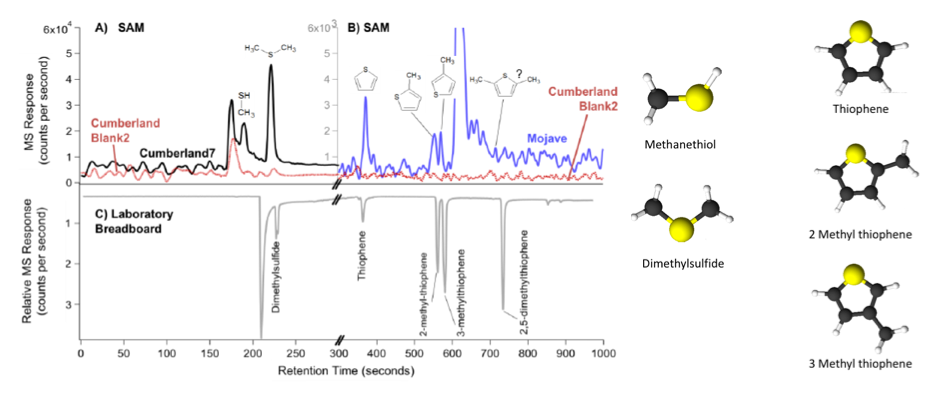A methane cycle on Mars
The first article focuses on the methane cycle taking place in the atmosphere. This molecule has been detected by SAM’s laser spectrometer (Tunable Laser Spectrometer – TLS) since the start of Curiosity’s operations on Mars in 2012. Its presence raises questions because it is normally destroyed in a few hundred years in Mars’ atmosphere.
It means that a contemporary source of methane exists on Mars’ surface. On Earth, the majority of atmospheric methane comes from living organisms but on Mars, the quantities measured are low enough so that the geochemistry alone (in the absence of life) may explain the observations. Thanks to measurements regularly performed by TLS for the 3 Martian years of the mission (≈6 years on Earth), a seasonal and repeatable variation of methane concentration has been highlighted.
These variations would be compatible with the presence of water clathrates in the Martian subsurface since those molecules are able to capture methane and release it when heated by the warmer surface temperatures of summer. This hypothesis is supported by the observation of the same variation in the quantity of water vapour and methane in the atmosphere. If the hypothesis is correct, the origin of methane could be even more complex to find because it could have an ancient origin and have been stored for billions of years within the Martian ground before being released over the seasons.

Seasonal evolution of the methane measured in Mars’ atmosphere by the TLS instrument from the SAM experiment on board the Curiosity rover (Webster et al., Science, 2018)
Sulphur-containing organic molecules on Mars
The second article reports the detection of sulphur-containing organic molecules in a Martian sample coming from the base layer of Mount Sharp, in the centre of Gale crater that Curiosity is climbing. This formation, and therefore the rocks that are present come from a lacrustine environment existing during the formation of Gale crater 3.5 to 3.8 billion years ago. Mojave is made of clays but also sulphites like jarosite.
This area is the result of a complex geochemical past of the planet, combining minerals forming in acid and oxidising conditions and mineral forming in alkaline or reducing conditions. During the analysis in the SAM instrument, samples of a few decigrammes from Majove were pyrolised (heated) up to > 850°C in the instrument’s ovens. The molecules released are analysed by a gaz chromatograph developed by French laboratories LATMOS, LISA and LGPM with support from CNES, combined with a mass spectrometer by the NASA Goddard Space Flight Center in the United States.
Chromatography separates individual components from a mixture of initial molecules and the mass spectrometry identifies them by molecular weighing. During the analysis of the Mojave sample, the simultaneous detection of sulphate decomposition products and organosulfur compounds such as thiophene and dimethylsulphide suggests that the molecules released were trapped and protected inside these minerals.
A second hypothesis on the origin of sulphur-containing organic molecules is that they come from highly complex and refractory organic matter that would begin to degrade at high temperatures. Whatever its origin, this organic matter means that a little more than 3.5 billion years ago, the crater Gale simultaneously combined all the conditions that allowed life to develop: perennial liquid water, energy, and organic matter. At the time when life appeared on Earth, the Gale crater on Mars was habitable.

Chromatograms of Cumberland and Mojave samples highlighting the sulphur-containing organic molecules (on the right) from the analysis of GCMS of these samples
(Eigenbrode et al., Science, 2018)
The discovery of sulphur-containing organic molecules in Martian rocks as well as the observation of a seasonal variation of the methane concentration in the atmosphere point to the chemical and geochemical hypothesis. However, these results do not exclude a potential biological origin that would explain these two phenomena just as well. A clear message is given by these results: not only the environment of Gale crater was conducive to the emergence of a life form, but the variety of molecules detected in different types of rocks also show a long-term preservation – on geological time scales of billions of years – of molecules of the past. These findings will be taken into account when selecting the landing and exploration sites for future space missions to Mars’ surface, such as the mission of the European Space Agency ExoMars 2020.
This work was largely funded by CNES. The Mars Science Laboratory mission was developed by NASA as part of its Mars Surface Exploration Program. Many French research laboratories and CNES are involved in this mission, mainly through the contribution to the SAM and ChemCam instruments.
REfErences
- Eigenbrode J. L., Summons R. E., Steele A., Freissinet C., Millan M., Navarro-González R., Sutter B., McAdam A. C., Franz H. B., Glavin D. P. and others. (2018) Organic matter preserved in 3-billion-year-old mudstones at Gale crater, Mars. Science, 360: 1096-1101.
- Webster C. R., Mahaffy P. R., Atreya S. K., Moores J. E., Flesch G. J., Malespin C., McKay C. P., Martinez G., Smith C. L., Martin-Torres J. and others. (2018) Background levels of methane in Mars’ atmosphere show strong seasonal variations. Science, 360: 1093-1096.
Contacts
- Francis Rocard Programme Manager of the Solar system programme at CNES: francis.rocard at cnes.fr
- Caroline Freissinet (LATMOS, CNRS, UVSQ, SU): caroline.freissinet at latmos.ipsl.fr / 01 80 28 52 69
- Cyril Szopa (LATMOS, UVSQ, CNRS, SU): cyril.szopa at latmos.ipsl.fr / 06 87 51 84 90
- Arnaud Buch (LGPM, CentraleSupelec): arnaud.buch at centralesupelec.fr / 01 75 31 61 91